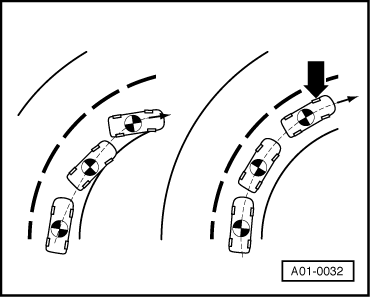A2
 |
|
|
 |
|
Lighting of the red "brake system malfunction" symbol indicates failure of EBPD. Extra caution must be taken if the vehicle has to be driven in this condition , "Test drive". For further information on actuation of warning lamps in connection with EBPD function, refer to: "Description of warning lamp functions" ABS: The ABS prevents locking of the wheels when the brakes are applied by the driver. It regulates the brake pressure applied to the individual wheel brake cylinders as a function of the rate of acceleration/deceleration at the wheels (which depends on the amount of wheel slip) in such a manner that the wheels can develop maximum road adhesion and thus the best possible braking effect. EDL: The electronic differential lock (EDL) is designed to provide assistance when driving off. Electronically controlled brake application on the spinning drive wheel provides a torque reaction point for the differential. This enables the wheel with the better traction to make use of the engine power. The EDL is also effective when reversing. In conjunction with ESP, EDL is active at vehicle speeds of up to 80 km/h. ASR: A prerequisite for the ASR function is that the ABS with EDL control unit -J104 can exchange data with the engine control unit and - in the case of vehicles with automatic gearbox - with the gearbox control unit. In other words, the control units must be able to communicate. Data are transferred by way of the CAN bus => Page 01-30. By reducing engine power, ASR stops the drive wheels spinning on acceleration. The function can be employed over the entire vehicle speed range. EDL and ASR complement one another when accelerating. ESP: ESP stands for Electronic Stability Program. It is designed to stabilise the dynamic handling response of the vehicle by counteracting any tendency towards oversteer or understeer. EBPD, ABS, EDL and ASR functions are incorporated into the system. Its characteristic feature is however controlled brake application at individual wheels. |
 |
|
|
Examples: → In the event of oversteer, the rear of the vehicle breaks away and the vehicle rotates further about its vertical axis than is required for cornering. The system counteracts this excessive movement by applying a controlled braking force at the outside front wheel. |
 |
|
|
→ In an understeer condition, the front end of the vehicle does not follow the required cornering radius and breaks away. The vehicle does not rotate far enough about its vertical axis to maintain course through the bend. The system increases the amount of rotation by applying a controlled braking force at the inside rear wheel. Attention:
Physical limits still apply even when using ESP. It is particularly important to bear this in mind on a slippery, wet road surface. Driving style must therefore always be adapted to road and traffic conditions. The enhanced level of safety provided by ESP does not mean that additional risks can be taken. |
